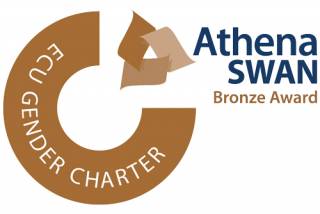Tuesday 8 May 2018
Lecture Theatre, British School at Rome, Via Antonio Gramsci 61, 00197, Rome.
Audio / Visual Romans seeks to explore the complex relationship between sound and image in films about ancient Romans: musical accompaniment as the aural encoding of history; film dialogue as the mechanism by which the past speaks in the present.
Afternoon Roundtable Discussion 15.30 - 17.00
and Evening Film Screening 18.00 - 20.00
FREE. ALL WELCOME. NO REGISTRATION REQUIRED.
You are welcome to attend either or both events.
- Afternoon Roundtable Discussion: Intersections between Sound and Image in Cinema
-
Chaired by Maria Wyke (University College London) & Monika Woźniak (La Sapienza).
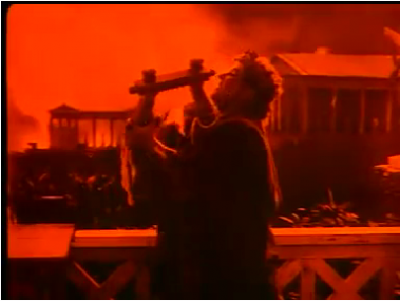
The imaginative power of cinema to shape our perception of the past is widely acknowledged. For spectators across the globe, film has often been their most immediate, personal, and seemingly authentic experience of Rome, and their visits to the city have thus been charged with cinematic memories of its distant past. Yet little attention has yet been paid to the complex relationship between sound and image in films about the ancient Romans. This roundtable discussion will focus on representations of Neronian Rome on screen in order to explore the intersection of the aural and the visual within them.
The music that accompanies these films provides an aural encoding of Roman history. It has to be relevant to the time of the films' production yet evocative of the past. It has also to build on earlier musical traditions or be devised from scratch. Music also is conventionally expected to draw spectators into cinema's Roman world and invite them to be moved by it. In sound film, dialogue too must be both comprehensible to audiences and compatible with the epoch presented on screen. Dialogue stakes a claim to history by anchoring protagonists and events in past time, establishing narrative coherence and revealing the personality of characters. It forms part of the conventions established in cinema for the portrayal of ancient Rome. Historical films' fictionalised Latin often follows invented patterns of communication that signal the classical past in a stilted literary style. Yet other films and types of musical accompaniment deliberately breach those conventions in order to construct a less comfortable relationship for spectators with the Roman past.
Monika Woźniak (La Sapienza) will introduce the 'aural costume' of Roman history films. Maria Wyke (UCL) will consider the silent Italian feature Quo vadis? (1913), Elisabetta Gagetti (Milan) the Italian version of 1924, and Amanda Bristow (UCL) the Hollywood version of 1951. Speakers will approach the sound of Nero's Rome from different disciplinary perspectives (linguistic, cinematographic, and musicological). There will be time for discussion.
- Evening Film Screening; Quo Vadis - 18.00 - 20.00
-
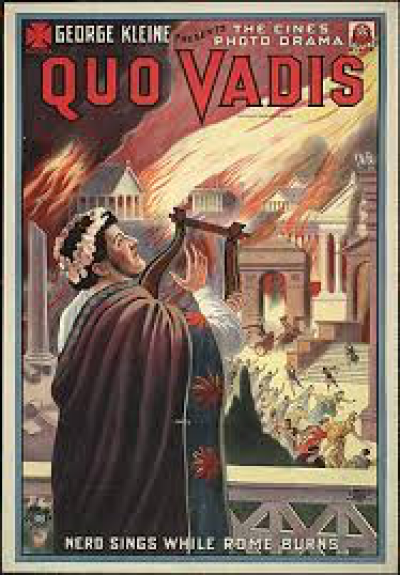
An evening's screening of the celebrated silent film set in Nero's Rome, Quo vadis? (1913, dir. Enrico Guazzoni) - from a restored print with English intertitles generously made available by EYE, the Netherlands Film Archive.
This feature film adaptation of the Polish novel by Henryk Sienkiewicz was a landmark in the history of cinema. It offers a dramatic and painterly representation of a depraved emperor and his imperial orgies, star-crossed love, the burning of Rome, lions in the arena, a girl rescued from a bull, and the visitation of Christ. Roman history gains life, colour, motion and music.
Introduced by Maria Wyke (University College London) & Monika Woźniak (La Sapienza) and accompaniment by an original score composed by Michele Sganga. He is a noted concert pianist, composer, and author of works on music history.
A landmark of cinema
Quo Vadis? was given a splendid premiere in Rome in March 1913, in the presence of ambassadors, politicians and literati. It had taken two years to shoot and was an extraordinary two hours long. This innovative work formed part of a drive to win authority for the new art of film as a product, particularly, of Italy. Bankers invested in the manufacture of films, as they had in cars and planes, to win prestige at home and aboard. With such backing, Italian films grew rapidly in length and frequently turned to the reconstruction of the nation's Roman past as a route to economic and aesthetic value. Such Roman films exploited complex literary narratives for their plots (Quo vadis? is an adaptation of the Polish novel by Henryk Sienkiewicz). They also displayed grand reconstructions of classical architecture, elaborately antiquarian décor and costumes, and filled the screen with hundreds of extras moving fluidly through spectacular three-dimensional sets of the ancient city.
An international success
Quo vadis? gained enormous international success for its technical and aesthetic sophistication. In Paris it was exhibited at the vast Gaumont Palace, able to accommodate thousands of spectators at a single screening. A review provides graphic evidence of how the musical accompaniment (drawn from an earlier operatic version of the novel) had brought the world of Neronian Rome to life the night before: 'From the first scenes, the work came alive. A phalanx of twenty-four musicians accentuated the dances at the feast. Nero sings his verses, his lyre vibrates. Rome is set on fire, the choir sings the hatred of the people… The prayer of the Christians in the catacombs and the blessing of Peter resounds through the sonorous voices of fifty choristers. The trumpets peal, the circus appears immense and packed with spectators, the chariots pass at a gallop, shouts acclaim the victors. Afterwards, plaintive and slow, comes the chant of the Christians who go to be tortured… Orchestra, soloists, and choir seem synchronized with the film and make of the spectacle a wonder of art'. (Le Courrier Cinématographique, 5 April 1913).
A synopsis
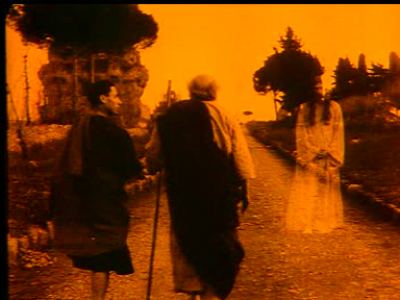
The film depicts the persecution of the Christians under the reign of Nero. Vinicius, a Roman patrician and nephew of Petronius, falls in love with a Christian girl named Lygia and eventually converts to the faith. Their love is obstructed by Nero, who burns Rome and places the blame on the Christians. The emperor sends Lygia into the arena on the back of a monstrous beast, but she is rescued by the strongman Ursus and Vinicius asks the crowd for mercy. Nero is overthrown and commits suicide. The title of the film (as of its source novel) evokes the question posed by Saint Peter as he encounters Christ on the Via Appia, quo vadis, domine? Peter returns to Rome to protect the faithful. The final shot shows Christ breaking the chains of suffering that bind his worshippers.
With: Carlo Cattaneo (Nero), Amleto Novelli (Vinicius), Lea Giunchi (Lygia), Gustavo Serena (Petronius), Ursus (Bruto Castellani), Saint Peter (Giovanni Gizzi).
The pianist and composer
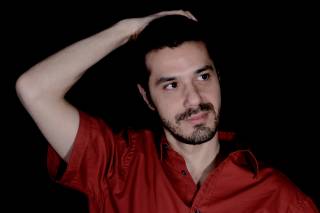
Michele Sganga graduated with honours in piano at the conservatory of Santa Cecilia in Rome, winning awards in national and international competitions. In addition, he graduated with honours in the History of Music at La Sapienza, supervised by Prof. Pierluigi Petrobelli.
Since 2013, Michele has performed in a number of concerts annually for the cycle Il respiro della musica organised by Paolo Terni as part of the Milanesiana festival. Among his recent works, in addition to two solo albums Animal Musicale. Biodiversity at the Piano and Reasons for Singing. Franz Liszt (Officina della Musica, 2012 and 2014), he has composed the soundtrack for the documentary Il testimone passato (Raistoria, 2015) and the stage music for a number of theatrical performances. In particular: La casta morta (2015, on the occasion of the centenary of the birth of Tadeusz Kantor), and Anamoni (2017, the associated CD was produced by Pescatori di Poesia Teatro and Compagnia Matroos). Included among his many piano recitals are: EuroPiano (performed at the opening of the 2014-2015 chamber season of the Krakow Philharmonic); Variations (Lugano, September 2015); Quo vadis? (commissioned by Koninklijk Nederlands Instituut Rome and CiakPolska Film Festival, 2016); and Magnificat sung for soprano and piano (Reggio Emilia,'Soli Deo Gloria', edition 2017). In addition to his concert performances and musical compositions, Michele has published academic studies on Chopin, Rossini, Nono and Tarkovskij, as well as popular works on opera for De Agostini Editore.
Organisers: Monika Woźniak (monika.wozniak@uniroma1.it) and Maria Wyke (m.wyke@ucl.ac.uk). Funded
by University College London's Regional Engagement Fund for Rome, and supported
by Sapienza, University of Rome, and the British School at Rome.
 Close
Close


